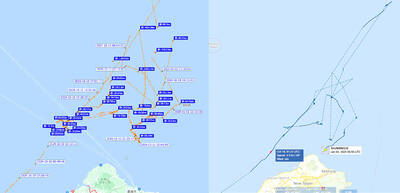One-quarter of the Chinese who visited Taiwan as foreign professionals last year have connections to political or government agencies and traveled to Taiwan to bolster Beijing’s “united front” tactics, Democratic Progressive Party Legislator Chen Chi-mai (陳其邁) said.
More than 183,000 Chinese visited on professional exchange permits, with 47,880, or 26 percent, having political or government backgrounds, Chen said, citing National Immigration Agency data.
Chen said that the number might be higher, as Chinese tourists reportedly often conceal their identities.
Chen referred to Wu Xin (吳昕), who purported to be a private citizen on an entry application, but was found to be an economic official in China’s Fujian Province.
Wu gained notoriety after entering a restricted room at a Chunghwa Telecom Co (中華電信) building and posting photographs online in October last year.
The agency said that Chinese with ties to official agencies must state that on their visa applications, adding that those who fail to do so would be barred from entering Taiwan — as Wu has been.
Chinese executives or “sensitive” Chinese citizens must obtain the approval of a joint review committee formed by the agency, the National Security Bureau, Mainland Affairs Council and other institutions, the agency said.
About 54 percent of those with political or government backgrounds, or 25,861, were of that nature last year, it added.
Chen said that visits by Chinese officials are aimed at bolstering the united front strategy, as Chinese officials have attempted to curry the favor of Taiwanese with large orders of agricultural products and other tactics.
President Ma Ying-jeou’s (馬英九) administration “opens the door, but fails to maintain security,” as the visa approval rate for Chinese applicants has reached about 90 percent and Chinese officials can easily conceal their identity and enter Taiwan, Chen said.
“We really are surrounded by Chinese spies,” he said.
It is easy for Chinese officials to hide their identities, as the visa system requires applicants to file an online request that the agency must review within 48 hours, preventing background checks on applicants.
The agency has “connived” with Chinese officials, allowing a meeting between Council of Agriculture Minister Chen Bao-ji (陳保基) and China’s Association for Relations Across the Taiwan Straits Deputy Chairman Zheng Lizhong (鄭立中) in October last year and another between Chen Bao-ji and China’s Taiwan Affairs Office Deputy Director Gong Qinggai (龔清概) in August last year, for which the agency has taken no disciplinary action, Chen said.

A strong continental cold air mass and abundant moisture bringing snow to mountains 3,000m and higher over the past few days are a reminder that more than 60 years ago Taiwan had an outdoor ski resort that gradually disappeared in part due to climate change. On Oct. 24, 2021, the National Development Council posted a series of photographs on Facebook recounting the days when Taiwan had a ski resort on Hehuanshan (合歡山) in Nantou County. More than 60 years ago, when developing a branch of the Central Cross-Island Highway, the government discovered that Hehuanshan, with an elevation of more than 3,100m,

Taiwan’s population last year shrank further and births continued to decline to a yearly low, the Ministry of the Interior announced today. The ministry published the 2024 population demographics statistics, highlighting record lows in births and bringing attention to Taiwan’s aging population. The nation’s population last year stood at 23,400,220, a decrease of 20,222 individuals compared to 2023. Last year, there were 134,856 births, representing a crude birth rate of 5.76 per 1,000 people, a slight decline from 2023’s 135,571 births and 5.81 crude birth rate. This decrease of 715 births resulted in a new record low per the ministry’s data. Since 2016, which saw

SECURITY: To protect the nation’s Internet cables, the navy should use buoys marking waters within 50m of them as a restricted zone, a former navy squadron commander said A Chinese cargo ship repeatedly intruded into Taiwan’s contiguous and sovereign waters for three months before allegedly damaging an undersea Internet cable off Kaohsiung, a Liberty Times (sister paper of the Taipei Times) investigation revealed. Using publicly available information, the Liberty Times was able to reconstruct the Shunxing-39’s movements near Taiwan since Double Ten National Day last year. Taiwanese officials did not respond to the freighter’s intrusions until Friday last week, when the ship, registered in Cameroon and Tanzania, turned off its automatic identification system shortly before damage was inflicted to a key cable linking Taiwan to the rest of

China’s newest Type-076 amphibious assault ship has two strengths and weaknesses, wrote a Taiwanese defense expert, adding that further observations of its capabilities are warranted. Jiang Hsin-biao (江炘杓), an assistant researcher at the National Defense and Security Research, made the comments in a report recently published by the institute about the Chinese Communist Party’s (CCP) military and political development. China christened its new assault ship Sichuan in a ceremony on Dec. 27 last year at Shanghai’s Hudong Shipyard, China’s Xinhua news agency reported. “The vessel, described as the world’s largest amphibious assault ship by the [US think tank] Center for Strategic and International